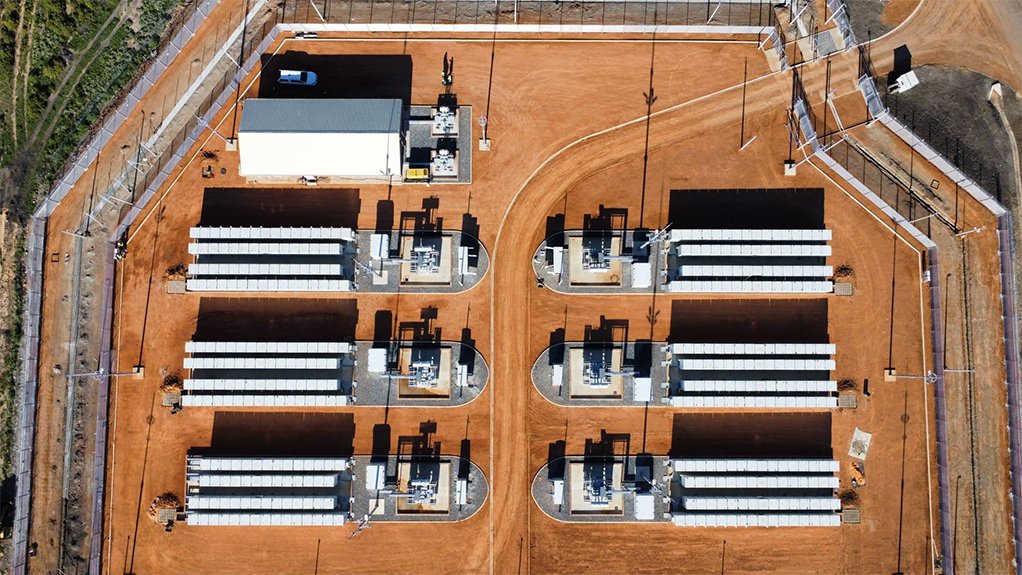Eskom has officially started operating the first of eight utility-scale battery energy storage system (BESS) projects being introduced as part of Phase 1 of a World Bank-funded programme to add batteries with a combined storage capacity of 199 MW and the ability to discharge 833 MWh of electricity over a minimum of four hours.
The project in question is the 20 MW/100 MWh Hex BESS site, which has been built on Eskom’s distribution network in Worcester in the Western Cape using batteries supplied by Hyosung, of South Korea.
It is the first Phase 1 project to be completed, but Eskom distribution group executive Monde Bala tells Engineering News that the seven other projects are all progressing on schedule, despite some initial delays at some sites.
Besides Hex, Phase 1 also comprises the 80 MW/320 MWh Skaapvlei, the 5 MW/30 MWh Graafwater and the 9.5 MW/45 MWh Paleisheuwel sites, also in the Western Cape; the 8 MW/32 MWh Elandskop and 40 MW/160 MWh Pongola projects, in KwaZulu-Natal; the 1.5 MW/6.16 MWh Rietfontein site, in the Northern Cape; and the 35 MW/140 MWh Melkhout site, in the Eastern Cape.
Last year, Eskom indicated that Hyosung and Pinggao, of China, had been awarded several of the Phase 1 projects following a competitive tender and indicated that the awards covered projects with a capital cost of some R4.4-billion.
Eskom and Hyosung officially opened the Hex BESS site on November 9, indicating that the 100 MWh of energy it could supply daily was equivalent to the consumption of a town the size of Mossel Bay, in the Western Cape, for about five hours.
Phase 1 also includes about 2 MW of solar photovoltaic (PV) capacity, which is being coupled to the Rietfontein project, to help ensure there is electricity for the project to store in a context of chronic supply constraints and Bala reports that Eskom distribution will consider further such couplings in future.
However, he stresses the division, which is currently being separated from generation and transmission, has capital constraints and that its main investment priority remains that of network maintenance and expansion.
It is, thus, considering various alternative funding models for future BESS and/or BESS-plus-renewables deployments, which Bala believes will become increasingly important as more variable renewable electricity is introduced and generation becomes more distributed across the country.
The phase 1 and 2 funding arises from a component of the $3.75-billion World Bank loan of 2010 initially earmarked for a concentrated solar project, which was subsequently replaced by BESS. The costs will be recovered by the tariff, with the BESS costs to be included in future revenue applications to the National Energy Regulator of South Africa.
PHASE 2 ON HOLD FOR NOW
Eskom has also placed Phase 2, through which it aims to introduce a further 144 MW/616 MWh of BESS across four sites, on hold. This, while it clarifies with National Treasury whether BESS projects can be included as part of the capital projects that the distribution business can undertake without breaching the terms of the R254-billion Eskom debt-relief conditions.
Bala is optimistic that permission will be granted and indicated an eagerness to press ahead with the projects at the earmarked sites of Witzenburg and Ashton, in the Western Cape, as well as Cuprum and Kiwano, in the Northern Cape.
He reports that the sites were selected primarily for the potential to use BESS to defer capital expenditure that would otherwise have been required, but says the division is also alive to the various services that BESS can provide to the grid, including ancillary services, such as frequency regulation, voltage support, and reactive power control.
For the Phase 1 projects, including Hex, the BESS will be used to manage peak demand periods (from 05:00 to 09:00 and between 17:00 and 21:00) by discharging stored energy during times of high electricity consumption, and recharging during off-peak periods.
This can reduce the strain on the grid during peak hours and help avoid the need for costly peak power plants, Bala explains. BESS can also limit the amount of curtailment imposed on variable renewable energy generators when the network is unable to absorb the electricity being produced.
However, in the absence of coupling with renewable generators the effectiveness of the initial BESS plants will also depend on Eskom ensuring that the country does not descend into intensive periods of loadshedding for extended periods.
If it does, there will be insufficient energy in the system to charge the batteries, as has sometimes been the case with the pumped storage schemes, which has resulted in Eskom resorting, at times, to replenishing reserves using the expensive diesel peaking plants.
Meanwhile, the Independent Power Producer Office (IPPO) reports that it is close to finalising the evaluation of 17 bids received in response to the country’s inaugural public procurement for BESS projects, launched in March.
Through the programme, government is aiming to procure BESS projects with a combined capacity of 513 MW and a minimum of four hours of storage, or at least 2 052 MWh.
A second BESS bidding round for 1 230 MW is currently scheduled to be launched in early 2024, but the IPPO has been unable to meet its schedule for the release of the seventh renewables round and a gas-to-power procurement, which were both already meant to be in the market.
EMAIL THIS ARTICLE SAVE THIS ARTICLE ARTICLE ENQUIRY
To subscribe email subscriptions@creamermedia.co.za or click here
To advertise email advertising@creamermedia.co.za or click here











